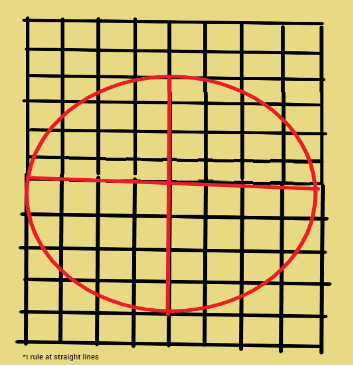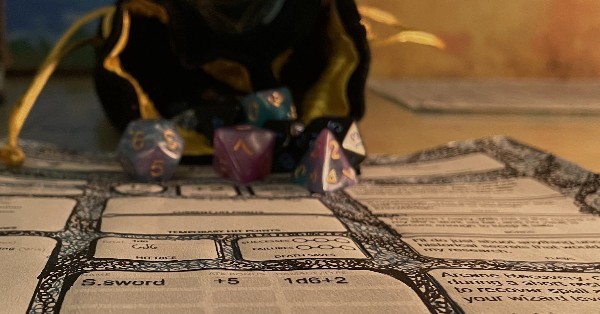For the duration, no sound can be created within or pass through a 20-foot-radius sphere centered on a point you choose within range. Any creature or object entirely inside the sphere is immune to thunder damage, and creatures are deafened while entirely inside it. Casting a spell that includes a verbal component is impossible there.
Casting Time: 1 action
Range: 120 feet
Components: V, S
Duration: Concentration, up to 10 minutes
School: 2nd-level illusion (ritual)
Player’s Handbook, pg. 275-6
Silence 5e
Silence has changed quite a bit since the first edition of Dungeons and Dragons, but it still serves its original functions admirably: shutting the yaps of muttering spellcasters and creating zones of total quiet/deafness.
While those seem like simple enough applications, players and DMs have plenty of questions about how exactly Silence works. We’ll go over that, as well as the best ways to use the spell for maximum effect and utility.
Who Can Cast Silence in 5e?
The following classes have Silence on their spell list:
The following subclasses get Silence for free:
-
Druid (Cirlce of the Land: Desert)
-
Warlock (The Undying) (SCAG 139)
-
Warlock (The Fathomless) (TCoE 72)
Way of Shadow Monks can also cast Silence by spending 2 ki points.
What Does Silence Do in 5e?
Silence creates a 20-foot radius sphere, in which no sound can be created and through which no sound can pass through. Creatures entirely inside the sphere are deafened, and both creatures and objects are immune to thunder damage.
The deafened condition is exactly what it sounds like: creatures that are deafened cannot hear and automatically fail ability checks that require hearing (PHB 290).
Casting a spell with a verbal requirement within the area of Silence is impossible. This is the really valuable part of the spell, because 94.5% of DnD 5e spells have a verbal component.
That’s DnD 5e’s Silence in a nutshell. Now onto the thornier rules questions.
What Are the Rules for Silence in 5e?
The rules for Silence in DnD 5e are as follows:
-
Silence is centered on a point, not a creature or an object. The spell’s description clearly states that the spell’s effect is “centered on a point you choose,” not a creature or an object. We also have Sage Advice confirmation. This means that Silence’s area of effect is effectively immobile unless re-cast.
This was a point of confusion for veterans of the game, since the version of Silence in the 1st edition of Dungeons and Dragons could target a creature or object and move with them.
-
A Readied Silence spell can interrupt the casting of a spell. Jeremy Crawford confirmed that, as a DM, he’d allow a Readied Silence spell to prevent the casting of a spell with a verbal component.
However, unlike Counterspell, an enemy won’t expend a spell slot in this scenario, since your Silence spell prevents them from casting it in the first place.
-
Silence doesn’t protect from incoming spells (unless they deal Thunder damage). Silence only prevents spells with a verbal component from being cast within its range. It has no effect on spells outside of its range, besides making them silent if/once they enter its space.
Of course, the spell explicitly states that creatures inside of Silence are immune from Thunder damage, so spells that deal Thunder damage are nullified by Silence.
-
Magic items that allow for spellcasting do not require verbal components. Things like staffs and wands can allow players and other creatures to cast spells. Notably, casting a spell via a magic item “requires no components, unless the item’s description says otherwise” (DMG 141).
Since the verbal component isn’t necessary to cast spells via (most) magic items, Silence has no effect on these sources of spells.
How Do I Use Silence in 5e?
Here are a few ways to use the Silence spell in DnD 5e:
-
Shut down spellcasters. Silence’s most obvious application is stopping spellcasters from casting spells. 96.5% of DnD 5e’s spells have a verbal component, so you’ve got pretty good coverage here.
Of course, Silence has a smallish area of effect, so how do you make sure that you get multiple rounds of utility from a single casting? That brings us to tip #2.
-
Work with your party to keep enemies in range of Silence. Grappling, restraining via spells like Ensnaring Strike, Web, and Entangle, push/pull effects like Thorn Whip, Eldritch Blast invocations, and Thunderous Smite, and slows like Spirit Guardians and Slow are all great things to pair with the Silence spell.
-
Put a silencer on the Knock spell. The Knock spell is great for unlocking locked doors, but it comes with a catch: it’s audible up to 300 feet away. That can put a real damper on your stealthy entry into your enemy’s inner sanctum.
But with the Silence spell, none will be wise to your magical breaking-and-entering. Note that you can’t actually cast the Knock spell within Silence’s range because it has a verbal component, but you can stand back and target a place within Silence’s range, and it still won’t make any noise.
-
Prevent enemies sounding the alarm. More of a niche use than most, but still highly effective in certain scenarios. A lone guy in a tower who’s trying to ring a bell to alert the encampment of your approach can’t do much about it if you cast Silence on the whole procedure.
-
Protect yourself from sound-based spells and effects. Another niche use, Silence is great for protecting yourself from Thunder spells. More than that, though, there are plenty of sound-based effects, like a Harpy’s Luring Song or the Dissonant Whispers, Vicious Mockery, or Command spells, that rely on hearing to work.
Using Silence on your own party in these situations can be just the kind of clever play that DMs love to see and players love to experience.
-
Keep your mission quiet. Here are a few scenarios when you might want to keep your party’s activities quiet:
-
Tunneling into/out of a lair/prison/etc.
-
Protecting crying villagers in an escort mission where you’re being hunted
-
Breaking through barriers/glass/etc. without alerting anyone
-
Firing cannons without a sound
-
-
Take advantage of ritual casting. Some players wonder why a “combat” spell like Silence can be cast as a ritual. The reason, I hope we’ve already made clear, is that Silence has other niche uses that aren’t always time-sensitive.
Being able to spend an extra 10 minutes casting Silence as a ritual means you get to hold onto your precious spell slots for when the combat situation does actually pop off.
-
Pair with hazardous terrain effects. While we mentioned literal crowd control effects that pair nicely with Silence already, there’s are other “soft” crowd control options at your disposal.
Putting something like Spike Growth on the only exit out of Silence’s area or making it seem unsafe to leave with something like Phantasmal Force are a few examples of what I’m talking about.
-
Silence imprisoned spellcasters. If you’re responsible for transporting a troublesome mage, you might not trust a gag to do the job. If it’s only a short journey, a few consecutive castings of the 10-minute spell might be enough to get the job done without the guy muttering some incantantation to get the slip.
Who Can I Target With Silence 5e?
You target a point space with Silence, not a creature or an object. The effect of Silence occupies a 20-foot radius sphere centered on the point you choose, which looks like this on a battle map where 1 square = 5 feet:

While the 1st edition of DnD version of Silence could follow a targeted creature if they failed their save or be cast on an object that could then be moved around after casting, the 5th edition version of Silence does not allow for either of these.
Is Silence 5e a Good Spell?
Yes, Silence is a good spell in DnD 5e, and you’ll find very few skilled players disagree with this assessment. At first glance, many new players think that Silence is incredibly easy to counter — just walk out of the sphere, and you’ve countered a 2nd-level spell with a single turn’s worth of movement.
But in practice, a party that works together with things like grapples, push/pull effects, and slows can put enemy spellcasters in truly hopeless positions. And since those are usually the most dangerous enemies you’ll face, Silence is useful for the entirety of a campaign.
Beyond its combat capability, Silence also comes with some fun extra utility. The ability to cast it as a ritual in non-time-sensitive missions means you often won’t even have to expend a spell slot to benefit from its effect.
Overall, your party will always be that much more prepared as long as one spellcaster has Silence ready to go.
Silence 5e DM Tips
As a DM defending against players who cast Silence on your spellcasters, you have a few things to consider. For starters, how do they react? Most creatures, especially those savvy enough to cast magic themselves, should realize that they’re in a completely silent area (total silence happening in the middle of a fight would be noticeable).
But do they think they’ve just been deafened, or do they realize that they’re in a zone of silence? That’s up to you, but in either case, they’ll realize that spellcasting isn’t working from where they’re standing, so they should most likely move away from where they are.
Whether they take the most direct path out of the zone of Silence is up to how meta-gamey you want to get, so try to balance your knowledge with the creature’s knowledge (no easy task).
As for DMing spellcasters that have Silence on their spell lists, employ the same tactics we suggested to players above. Pair the spell with push/pull effects, grapplers, and dangerous terrain effects/environmental conditions.
It can also be good to cast Silence on imprisoned spellcasters to prevent them from using any of their tricks to get out of their situation. Note that the 10-minute duration does limit the long-term feasibility of this tactic.
Silence FAQ
-
How does Silence work in 5E?
Silence creates a 20-foot radius sphere where no sound can be created or pass through. Creatures inside the sphere are deafened, and spells with verbal components cannot be cast within its range.
-
Can you cast Silence on a creature?
No, Silence is centered on a point, not a creature or object. Its effect is immobile unless recast.
-
Why is Silence not a wizard spell?
Silence is not a wizard spell by default in D&D 5E. It is available to classes such as Bard, Cleric, Ranger, Druid (Circle of the Land: Desert), Warlock (The Undying and The Fathomless), and Way of Shadow Monks.
-
Does Silence cancel abilities?
Silence does not cancel abilities unless they rely on sound or require a verbal component. It primarily affects spellcasting with verbal components and grants immunity to thunder damage within its range.
Simple Silence 5e Spell Text
Silence: (2nd-level illusion (ritual), 120 feet, Concentration, up to 10 minutes, V/S) No sound can be created within or pass through a 20-foot-radius sphere centered on a point you choose. Creatures and objects inside are immune to thunder damage and deafened while entirely inside the sphere. Casting a spell with a verbal component is impossible there.

![Spike Growth 5e [DnD Spell Guide: Uses, Rules, Tips] entangle-5e-druid](https://www.dndlounge.com/wp-content/uploads/2022/03/entangle-5e-druid-300x174.jpg)
![Shillelagh 5e [DnD Spell Guide: Uses, Rules, Tips] owlbear-dnd-5e](https://www.dndlounge.com/wp-content/uploads/2022/03/owlbear-dnd-5e-300x218.jpg)
![Shape Water 5e [DnD Spell Guide: Uses, Rules, Tips] dnd-5e-character-sheet-and-die](https://www.dndlounge.com/wp-content/uploads/2022/03/dnd-5e-character-sheet-and-die-300x157.jpg)
![Aura of Vitality 5e [DnD Spell Guide: Uses, Rules, Tips] dungeons-and-dragons-party-vs-blue-dragon](https://www.dndlounge.com/wp-content/uploads/2022/03/dungeons-and-dragons-party-vs-blue-dragon-300x223.jpg)